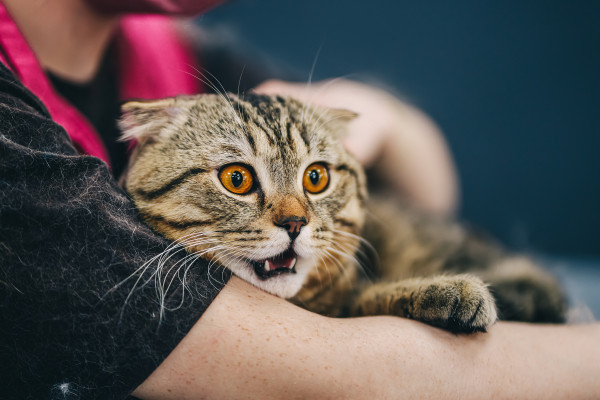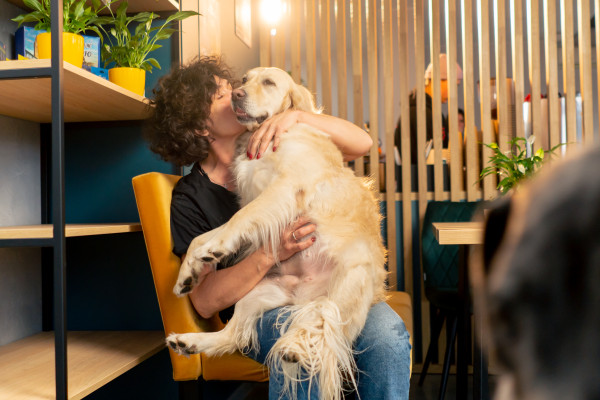
The Surge in Pet Anxiety—Are We to Blame?
Recent data paints a concerning picture: since 2019, anxiety-related insurance claims for dogs and cats have surged by 93%. This has been seen in states like Washington, Louisiana, and North Carolina, with some states reporting increases of up to 150%.
In 2023, more than 25,000 pet insurance claims were filed for anxiety-related concerns through Trupanion, a whopping 93% increase from 2019. Breeds such as Australian cattle dogs, terriers, Portuguese water dogs, Shetland sheepdogs, and American pit bull terriers have been noted to be among the most affected, while Siamese, Bengal, and Siberian cats lead these claims on the feline side.
While the causes of this dramatic rise are complex and not fully understood, a growing body of research suggests that our pets may be absorbing more of our emotional stress than we realize.

Photo by kau1st0
Feeding the Problem
Studies show that dogs and their owners are deeply connected—not just emotionally, but physiologically. For example, in a pivotal 2019 study, researchers found that cortisol levels (a marker of chronic stress) in dogs’ hair were significantly correlated with the hair cortisol levels of their owners. This mirrored stress pattern was observed across summer and winter seasons, highlighting a persistent link.
Additional research has shown that dogs often adopt their owners' emotional states through a phenomenon known as “emotional contagion.” Traits such as anxiety, restlessness, and even neuroticism can, over time, “rub off” on dogs, especially in households where stress is high and consistent. This happens because dogs are highly attuned to human body language, tone of voice, and routines. Over time, they begin to mirror the emotional states of their caretakers as part of their social bonding and survival behavior.
One recent study revealed that dogs whose owners frequently ruminate on work-related stressors are more likely to exhibit anxious behaviors, such as whining, pacing, or appearing agitated. This “crossover stress” often goes unnoticed. Owners may believe their pet is simply acting out when, in reality, the dog may be reflecting its human’s internal turmoil.
Veterinary behaviorists and trainers have long recognized this dynamic and warn that anxious tones, body language, and even human scent changes can heighten a dog’s distress. Over-comforting or nervous reassurances like, “You’re okay!” may actually exacerbate the situation, whereas a calm, confident demeanor can help dogs feel secure.
Peer-reviewed studies support the idea that this is a two-way street. A 2024 literature review noted that behavioral issues in dogs often increase owners’ stress, creating a feedback loop of anxiety. This has also been demonstrated in another research study—dog owners with high levels of anxiety and depression are more likely to have dogs with behavioral concerns. This underscores the need for treatment approaches that consider both members of the human-animal bond.
And it's not just dogs. Cats, horses, and other companion animals are also sensitive to their owners’ emotional and behavioral states. A 2020 study found that cats form secure and insecure attachment styles to their human caregivers, much like infants and dogs do, and that owner behavior influences the cat’s stress response and social confidence. In horses, research has shown that riders’ emotional states can affect equine heart rate and behavior, with nervous or anxious handlers often eliciting increased tension, avoidance, or reactive behavior in the horse.
These findings emphasize the importance of emotional awareness not just for dogs, but across all household and companion animals. Like dogs, these animals rely on predictability, calm interactions, and routine to feel safe, making the emotional environment of the household or stable a crucial factor in their behavioral well-being.

Photo by guyswhoshoot
Turning the Tide Together
Addressing pet anxiety can be addressed using a holistic approach. Behavioral modification, especially desensitization and reward-based training, can help pets develop confidence in stressful situations. Environmental enrichment, such as daily exercise, puzzle feeders, and dedicated rest zones, can significantly reduce anxiety.
Importantly, owners must also prioritize their mental health. Positive mental health exercises for humans, like practicing mindfulness, setting healthy work-life boundaries, and seeking therapy, can indirectly benefit pets, as well.
The key takeaway? Pet anxiety is real and on the rise, and often reflects the emotional state of their human companions. By supporting both the pet and the owner, this vicious cycle can potentially be broken. Recognizing this deeply intertwined relationship allows us to grow and thrive together.
Follow us on LinkedIn for the latest updates on all things happening here at BSM Partners.
About the Author
Dr. Katy Miller works as the Director of Veterinary Services at BSM Partners. She earned her veterinary degree at Ross University and completed her clinical year at Louisiana State University. She previously served for 11 years as the Director of Dog and Cat Health and Nutrition for Mud Bay where she earned multiple certifications and specialized in pet food nutrition, prior to which she practiced general and emergency medicine for seven years. She is also a competitive three-day eventer, licensed falconer, and claims only two (Golden and Mini Doxie) of their nine dogs.
This content is the property of BSM Partners. Reproduction or retransmission or repurposing of any portion of this content is expressly prohibited without the approval of BSM Partners and is governed by the terms and conditions explained here.